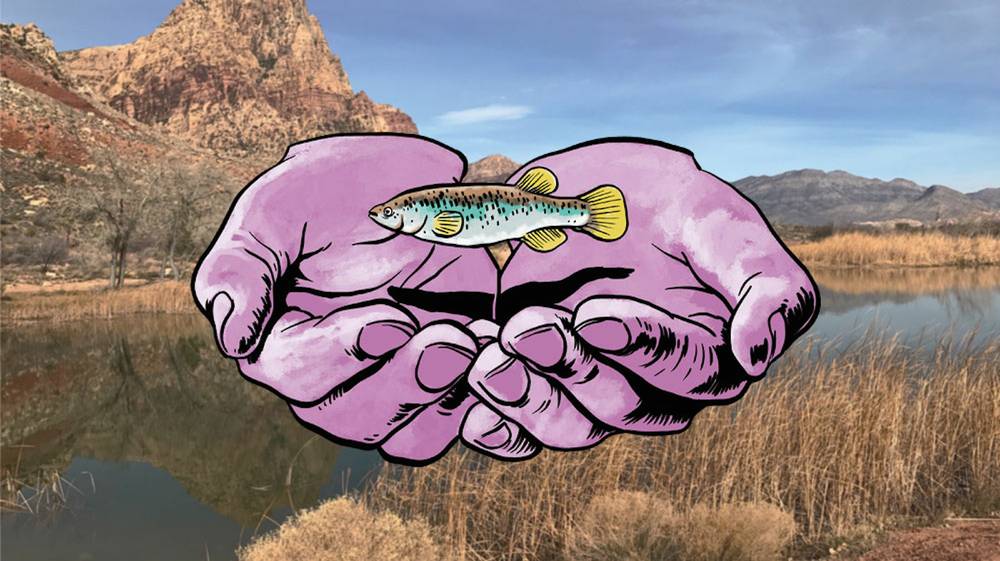This is a story of desert endurance. It stars a population of native Nevadans, a rare and sturdy stock of hard-luck survivors. And like all desert stories, it begins and ends with water. This one just begins a little earlier than most.
Once upon a time during Southern Nevada’s Ice Age, fish teemed in vast rain-fed lakes, while mammoths, camels and giant sloths roamed the land. Eventually, over the course of thousands of years, the waters receded into desert, and the fantastic beasts hardened into fossils. But a few of those teeming fish—tiny, unassuming ones the length of a child’s palm—survived in what little water was left behind: Manse Spring in Nye County.
The Pahrump poolfish, as it’s known today, is an “evolutionary miracle,” according to Kevin Guadalupe, a biologist for the Nevada Department of Wildlife specializing in native fish and amphibians. “It should have died off.” Yet the scrappy creature found a way to subsist in extreme isolation, with temperatures hot enough to kill most other fish. Guadalupe describes the various warm springs that have incubated the poolfish and other similar desert fish (they’re pretty much all endangered) as “some of the rarest, most unique spots in the world.”
Of course, everybody wants water in the desert. Rare natural spectacles often conflict with “progress.” As human populations increased, the fortunes of the Pahrump poolfish and its relatives declined.
During the 1940s, right about when the Flamingo Hotel and Huntridge Theatre were built, the Ash Meadows poolfish went extinct. Nobody knows exactly what did them in, but the theory is a lethal combination of habitat destruction and invasive species, like crayfish and mosquitofish, which ate them. Then in the ’50s, just as UNLV was being established, the Raycraft Ranch springfish and the Pahrump Ranch poolfish were snuffed out as a result of human activity. By the time the “Welcome to Fabulous Las Vegas” sign was built in 1959, the Pahrump poolfish (aka Empetrichthys latos) was the only remaining species in its genus. Less than 10 years later, it would be listed as Endangered.
In 1975, Manse Spring dried up due to groundwater pumping, and the native Nevadans lost their home. According to human laws, it wasn’t their home anyway. The poolfish’s ancient habitat happened to be on private property.
The poolfish seemed destined to follow the rest of its genus to a watery grave. But this time the fish had a new defender. The late UNLV biologist James Deacon famously salvaged the species by carrying 32 of them out in a bucket. He would go on to launch UNLV’s environmental studies program and co-write a book considered the bible for fish recovery: Battle Against Extinction: Native Fish Management in the American West.
Years later, when biologist Kevin Guadalupe was just an science-loving freshman at UNLV, he discovered a copy of Battle Against Extinction in a case at Lied Library. He’d always been an outdoorsman, but that book determined his career and inspired a mission of fish research and conservation. “There are more species of fish than there are of any other vertebrate animal,” Guadalupe says. “The fact that we have some of the rarest and most isolated on the planet—that’s what fascinates me.”
Lake Harriet at Spring Mountain Ranch State Park is almost as artificial as the lake in front of the Bellagio. But instead of cascading fountains, visitors enjoy pristine views of Red Rock Canyon National Conservation Area. It’s a great place for an afternoon stroll or a short hike. For a small donation at the visitor’s center, guests can feed apples to Penelope the cow.
Since 1983, Lake Harriet has also been the most successful refuge for Pahrump poolfish. In 2015, the population exceeded 10,000. Interestingly, they grew larger in Lake Harriet, where there was more space and the water was cooler, than they had in their original home. But a year later, the numbers crashed. By August 2016, fewer than 300 Pahrump poolfish could be found in Lake Harriet. Another salvage operation evacuated them to a tank in a fish hatchery at Lake Mead. “It looks like a giant jacuzzi,” Guadalupe says.
If everything goes according to schedule, Guadalupe hopes to drain the lake this month. He’s busy navigating conference calls, piping orders and work dates. Once the lake is “dessicated,” Guadalupe and his colleagues will let it dry out for a year. It’s the only way to kill off the scourge that has overtaken the lake and eaten the vulnerable Pahrump poolfish: red swamp crayfish and mosquitofish.
How did these devastating predators get into Lake Harriet? Who or what would do such a thing?
You did, I’m sad to say. It’s awkward to call you out like this after we’ve spent nearly 900 words getting to know one another. But it’s the message Guadalupe wants everyone to internalize: Don’t release your pets and aquatic species into the waters. “I don’t think people realize when they do that how costly it can be. … It’s extremely destructive and against the law,” he says. And he’s seen it all: people releasing their koi fish; dragging a cooler out to a lake and dumping the live remains of a water feature; somebody even hiked up and put Molly fish in a waterfall. The state biologist would love to create a public awareness program about the proper disposal of fish, perhaps something along the lines of Utah’s “Don’t Ditch a Fish” campaign. But with so many conservation projects on his plate, he hasn’t had time to solidify ideas.
Guadalupe is “fairly optimistic” about the prospects for the Pahrump poolfish. Restoration projects have a trajectory of 40 years, he explains. “We’re hoping for 40 years of stability."
Mike Tonemah was born into a love of fish. His mom kept fish before he was born, and he hasn’t spent a day of his life without them. “If I’m sitting in front of a fish tank, that’s my paradise,” Tonemah says. “One fish tank turned into five. Five turned into 10. I had like 17 aquariums in my house before I opened this place.”
Young, friendly and generously tattooed, Tonemah has owned and operated the Fish Shop in Henderson for nearly three years. In that much time, he’s seen invasive fish in all the local waters. “There’s turtles that are found a thousand miles from here swimming in Sunset Park.”
Aquarium stores want to be good citizens and responsible stewards of the environment. Tonemah says all the aquariums in town, his included, will gladly accept unwanted fish as a way to prevent them from destroying local ecosystems. Depending on the situation, he’ll even offer store credit or trade.
“Put ’em in a bucket, put ’em in a bag. Just bring ’em here. I’d rather us take them than you flush them down the toilet or dump them in Sunset Park.”





